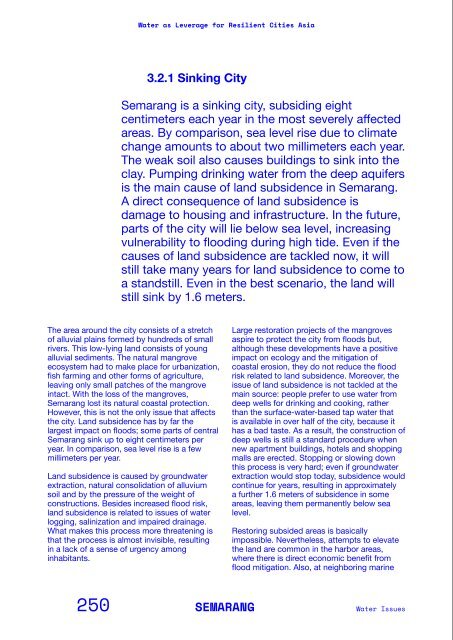Water as Leverage- Setting the scene for a call for action
- No tags were found...
Create successful ePaper yourself
Turn your PDF publications into a flip-book with our unique Google optimized e-Paper software.
<strong>Water</strong> <strong>as</strong> <strong>Leverage</strong> <strong>for</strong> Resilient Cities Asia <strong>Setting</strong> <strong>the</strong> Scene <strong>for</strong> a Call <strong>for</strong> Action Content<br />
3.2.1 Sinking City<br />
Semarang is a sinking city, subsiding eight<br />
centimeters each year in <strong>the</strong> most severely affected<br />
are<strong>as</strong>. By comparison, sea level rise due to climate<br />
change amounts to about two millimeters each year.<br />
The weak soil also causes buildings to sink into <strong>the</strong><br />
clay. Pumping drinking water from <strong>the</strong> deep aquifers<br />
is <strong>the</strong> main cause of land subsidence in Semarang.<br />
A direct consequence of land subsidence is<br />
damage to housing and infr<strong>as</strong>tructure. In <strong>the</strong> future,<br />
parts of <strong>the</strong> city will lie below sea level, incre<strong>as</strong>ing<br />
vulnerability to flooding during high tide. Even if <strong>the</strong><br />
causes of land subsidence are tackled now, it will<br />
still take many years <strong>for</strong> land subsidence to come to<br />
a standstill. Even in <strong>the</strong> best scenario, <strong>the</strong> land will<br />
still sink by 1.6 meters.<br />
villages, land owners are elevating <strong>the</strong>ir<br />
land and public space. This results in <strong>the</strong><br />
phenomenon of ‘sinking houses’, buildings<br />
where <strong>the</strong> ground floor slowly disappears<br />
below <strong>the</strong> surface, <strong>for</strong>cing people to move to<br />
<strong>the</strong> first floor and, if <strong>the</strong>y can af<strong>for</strong>d it, build<br />
ano<strong>the</strong>r floor on top.<br />
The waterways are not only used <strong>for</strong> w<strong>as</strong>te<br />
disposal; <strong>the</strong>y provide vital resources <strong>as</strong> well.<br />
Semarang’s water network is mostly supplied<br />
by <strong>the</strong> Jatibarang reservoir and <strong>the</strong> Semarang<br />
river. Never<strong>the</strong>less, most industrial, residential<br />
and business complexes tend to pump up <strong>the</strong>ir<br />
own water from <strong>the</strong> aquifers. As mentioned<br />
be<strong>for</strong>e, this h<strong>as</strong> contributed to land subsidence<br />
and salt water intrusion issues in central and<br />
co<strong>as</strong>tal are<strong>as</strong>.<br />
Natural compression<br />
Sinking houses<br />
Road<br />
elevation<br />
Load of buildings<br />
and infr<strong>as</strong>tructure<br />
Groundwater extr<strong>action</strong><br />
The area around <strong>the</strong> city consists of a stretch<br />
of alluvial plains <strong>for</strong>med by hundreds of small<br />
rivers. This low-lying land consists of young<br />
alluvial sediments. The natural mangrove<br />
ecosystem had to make place <strong>for</strong> urbanization,<br />
fish farming and o<strong>the</strong>r <strong>for</strong>ms of agriculture,<br />
leaving only small patches of <strong>the</strong> mangrove<br />
intact. With <strong>the</strong> loss of <strong>the</strong> mangroves,<br />
Semarang lost its natural co<strong>as</strong>tal protection.<br />
However, this is not <strong>the</strong> only issue that affects<br />
<strong>the</strong> city. Land subsidence h<strong>as</strong> by far <strong>the</strong><br />
largest impact on floods; some parts of central<br />
Semarang sink up to eight centimeters per<br />
year. In comparison, sea level rise is a few<br />
millimeters per year.<br />
Land subsidence is caused by groundwater<br />
extr<strong>action</strong>, natural consolidation of alluvium<br />
soil and by <strong>the</strong> pressure of <strong>the</strong> weight of<br />
constructions. Besides incre<strong>as</strong>ed flood risk,<br />
land subsidence is related to issues of water<br />
logging, salinization and impaired drainage.<br />
What makes this process more threatening is<br />
that <strong>the</strong> process is almost invisible, resulting<br />
in a lack of a sense of urgency among<br />
inhabitants.<br />
Large restoration projects of <strong>the</strong> mangroves<br />
<strong>as</strong>pire to protect <strong>the</strong> city from floods but,<br />
although <strong>the</strong>se developments have a positive<br />
impact on ecology and <strong>the</strong> mitigation of<br />
co<strong>as</strong>tal erosion, <strong>the</strong>y do not reduce <strong>the</strong> flood<br />
risk related to land subsidence. Moreover, <strong>the</strong><br />
issue of land subsidence is not tackled at <strong>the</strong><br />
main source: people prefer to use water from<br />
deep wells <strong>for</strong> drinking and cooking, ra<strong>the</strong>r<br />
than <strong>the</strong> surface-water-b<strong>as</strong>ed tap water that<br />
is available in over half of <strong>the</strong> city, because it<br />
h<strong>as</strong> a bad t<strong>as</strong>te. As a result, <strong>the</strong> construction of<br />
deep wells is still a standard procedure when<br />
new apartment buildings, hotels and shopping<br />
malls are erected. Stopping or slowing down<br />
this process is very hard; even if groundwater<br />
extr<strong>action</strong> would stop today, subsidence would<br />
continue <strong>for</strong> years, resulting in approximately<br />
a fur<strong>the</strong>r 1.6 meters of subsidence in some<br />
are<strong>as</strong>, leaving <strong>the</strong>m permanently below sea<br />
level.<br />
Restoring subsided are<strong>as</strong> is b<strong>as</strong>i<strong>call</strong>y<br />
impossible. Never<strong>the</strong>less, attempts to elevate<br />
<strong>the</strong> land are common in <strong>the</strong> harbor are<strong>as</strong>,<br />
where <strong>the</strong>re is direct economic benefit from<br />
flood mitigation. Also, at neighboring marine<br />
Semarang is subiding;<br />
<strong>the</strong> weak soil causes<br />
buildings to sink into<br />
<strong>the</strong> clay, <strong>for</strong>cing home<br />
owners to give up <strong>the</strong>ir<br />
ground floor.<br />
Urban developments in<br />
flood prone are<strong>as</strong>.<br />
250 SEMARANG<br />
<strong>Water</strong> Issues<br />
PART 2/Background In<strong>for</strong>mation on <strong>the</strong> Partner Cities<br />
251


















